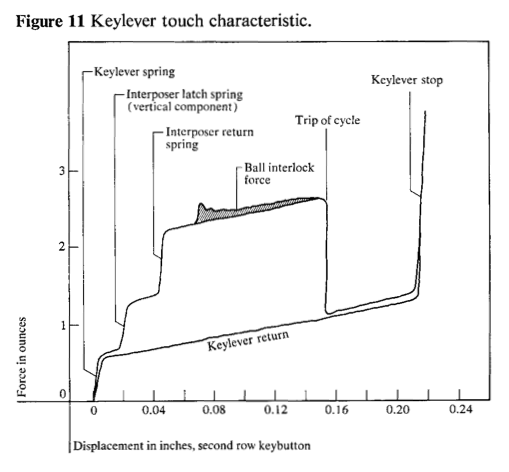I will say that Alps clicky switches are probably the closest I've gotten to Selectric in a computer keyboard, but that's still a very long way away.
In prose, I would describe how the Selectric feels by how it
works. First up, have a force graph:

There's a very, very light leaf spring with 5.6 mm travel that makes up the linear component of the Selectric's travel. This bottoms out at about 37 cN.
The tactility and actuation are provided by a separate mechanism from that (which is, to be fair, also true of Cherry - Alps separates tactility and actuation from one another). However, Selectrics do it in a way that doesn't resemble anything that a computer keyboard can possibly do. The keylever engages an interposer, which is on a stiff spring (actually, two stiff springs which are engaged separately), and force goes up from about 17 cN (after the .1 mm of travel to load the linear spring) to about 62 cN very quickly (at about 1.3 mm of total travel). Meanwhile, the interposer is pushing against a bail that mechanically engages the print mechanism, and at about 3.8 mm of total travel, and 71 cN force (note how long you spend pushing the interposer against the bail, which gives a huge meaty tactile bump), the print mechanism engages, and this is where the real magic happens.
The force graph doesn't tell you everything that happens here, either, is the thing. The force graph shows a vertical dropoff.
What actually happens is that a camshaft actually KNOCKS THE INTERPOSER OUT FROM UNDER THE KEYLEVER. The key falls out from under your finger, dropping from 71 cN to about 31 cN force instantly. Because your finger isn't providing the force for this tactile drop, that's why it feels like the key falls away from you.
Finally, at about 5.6 mm of travel, the ride's over, and you bottom out.
Releasing the key is done purely against the leaf spring, so it's light, there's no reverse tactile sensation, nothing forcing your finger up hard.